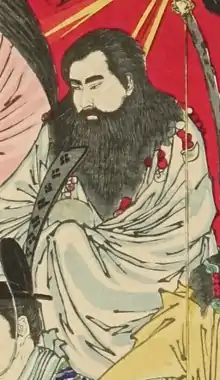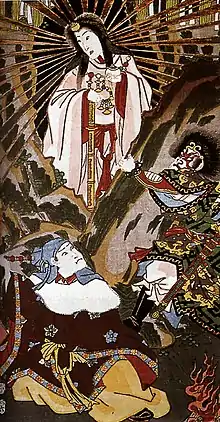Ninigi-no-Mikoto
Ninigi-no-Mikoto (Japanese: 瓊瓊杵尊) is a deity in Japanese mythology.[1] Grandson of the sun goddess Amaterasu,[2] Ninigi is the great-grandfather of Japan’s first emperor, Emperor Jimmu.[3] His descent from Heaven brought rice and order to earth.[1][4] The three sacred treasures brought with Ninigi from Heaven and divine ancestry established the Japanese Imperial Family.[5][6]
| Ninigi-no-Mikoto | |
|---|---|
 | |
| Personal information | |
| Parents | Ame-no-oshihomimi (father) Takuhadachiji-hime (mother) |
| Consorts | Konohanasakuya-hime (wife) |
| Children | Hoderi, Hosuseri, Hoori, Hikohohodemi, Tamanoya |
Name and etymology

Ninigi-no-Mikoto (瓊瓊杵尊), means “The Great God Ninigi.” Another name of his is Ame-nigishi-kuni-nigishi-amatsuhiko-hiko-ho-no-ninigi-no-Mikoto (天邇岐志国邇岐志天津日高日子番能邇邇芸命) or “The Great God Ninigi, of the Imperial State, The Child of the Sun of Many Talents." Ninigi is speculated to be translated as “beloved jeweled mallet.”[1]
He may also be referenced as Honinigi.[3]
Myths
Birth
In most versions Ninigi was born from Ame-no-oshihomimi and Takuhadachiji-hime.Takamimusubi, treated him with special affection, and nurtured him with great regard.[7]
Send to rule
Depending on the version Amaterasu sends Ninigi to rule either after his father refuses the offer, after several failures, or to replace Ōkuninushi after his troubled rule.[8][9]
In many stories, Ninigi receives three gifts. The sword Kusanagi, the mirror Yata no Kagami, and the jewel Yasakani no Magatama.[10][11][12]
Other variants say that Amaterasu also gives Ninigi an ear of rice to give food to the people.[13]
Descent to earth

Ninigi's descent to earth appears in both the Nihon Shoki and the Kojiki.
In a earlier version of the Nihon Shoki Ninigi descends to earth unaccompanied.[14]
But in a later version of the Nihon Shoki and the Kojiki, other gods accompany Ninigi’s journey to earth; who accompanies him and how many depends on the version. But it usually includes the following gods. Uzume, Sarutahiko, Ame-no-Koyane, Futodama, Ishikori dome, and Tamanoya; many of these deities would later become the ancestors to many clans like Sarume clan , Nakatomi clan, Shinabe clan ,and Inbe clan[14]
Ninigi tries to go to earth but he is blocked by Sarutahiko. Uzume then persuades Sarutahiko to let Ninigi pass.[15][16]
In most versions Ninigi descents to earth landing on to Mt. Takachiho located on the island of Kyushu in Kagoshima Prefecture where Ninigi built his palace there.[17][18][13][19]
Loss of immortality
One story involves Ninigi looking for a wife; he meets this mountain god named Oyamatsumi, Oho-Yama presents Ninigi his two daughters Konohana and Iwa-Naga. However, Ninigi regrets Iwa-Naga for her looks and is cursed for regretting Iwa-Naga. Now he and his descendants will live shorter lives.[20][21]
Birth of Ninigi’s children
Soon after Ninigi and Konohanasakuya-hime got married, Konohanasakuya-hime got pregnant. Ninigi accused his wife of adultery. In many versions his wife decided to went in to a hut and set the hut on fire to prove that she was a faithful wife. Konohanasakuya-hime and her sons survived, she gave birth to three sons named Hoderi, Hoori, and Hosuseri.[22]
One variation says that Konohanasakuya-hime gave birth to Hoderi in the hut and had the other two children later.[23]
Family
| Takamimusubi | Amaterasu | ||||||||||||||||||||||||||
| Takuhadachiji-hime | Ame-no-oshihomimi | Ōyamatsumi | |||||||||||||||||||||||||
| Ninigi | Konohanasakuya-hime | ||||||||||||||||||||||||||
| Hoderi | Hosuseri | Hoori | |||||||||||||||||||||||||
Many versions have Amaterasu and Takamimusubi as Ninigi's grandparents ,and the son of Ame-no-oshihomimi and Takuhadachiji-hime.[24] Ninigi is said to be the nephew to Futotama and Ame-no-Koyane.[25]
Children
Most stories state that Ninigi had three sons Hoderi, Hosuseri, and Hoori. However, other ancient Japanese texts say that he had four sons and lists "Hikohohodemi no mikoto" as the fourth child of Ninigi. However, it isn’t clear if Hikohohodemi is a fourth child or another name of Hoori.[1]
According to Nihongi, Tamanoya is a offspring of Ninigi.[19]
Worship
There are shrines dedicated to the god including Amatsu Shrine and Kirishima-jingu Shrine.[26][27]
See also
References
- "Ninigi". Mythopedia. Retrieved 2020-09-30.
- Borgen, Robert; Ury, Marian (April 1990). "Readable Japanese Mythology: Selections from Nihon shoki and Kojiki" (PDF). The Journal of the Association of Teachers of Japanese. American Association of Teachers of Japanese. 24 (1): 61-97. doi:10.2307/489230. JSTOR 489230. Retrieved 12 April 2020.
- Willis, Roy, ed. (2006). World Mythology: The Illustrated Guide. New York: Oxford University Press. pp. 114, 116, 120. ISBN 978-0-19530752-8.
- Huffman, James L. (2010). Japan in World History. New York: Oxford University Press. p. 13.
- Sykes, Egerton (1993). Kendall, Alan (ed.). Who's Who Non-Classical Mythology. New York: Oxford University Press. p. 141.
- Ashkenazi, Michael (2003). Handbook of Japanese Mythology. Santa Barbara, California: ABC-CLIO. p. 137. Retrieved 27 October 2020.
- https://en.wikisource.org/wiki/Nihongi:_Chronicles_of_Japan_from_the_Earliest_Times_to_A.D._697/Book_II
- Ashkenazi, Michael (2003). "Ninigi-no-Mikoto". Handbook of Japanese mythology. Santa Barbara, California: ABC-CLIO. p. 222. ISBN 9781576074671.
- Roberts, Jeremy (2009). Japanese Mythology A to Z. Infobase Publishing. ISBN 978-1-4381-2802-3.
- "Ninigi | Japanese deity". Encyclopedia Britannica. Retrieved 2020-09-30.
- "Ninigi". Mythopedia. Retrieved 2020-09-30.
- Coulter, Charles Russell; Turner, Patricia (2013-07-04). Encyclopedia of Ancient Deities. Routledge. ISBN 978-1-135-96397-2.
- "[Soul of Japan] Ninigi-no-Mikoto, the Kami Who Established A Nation". JAPAN Forward. 2019-11-08. Retrieved 2020-09-30.
- Hardacre, Helen (2017). Shinto: A History. Oxford University Press. ISBN 978-0-19-062171-1.
- Picken, Stuart D. B. (2004). Sourcebook in Shinto: Selected Documents. Greenwood Publishing Group. ISBN 978-0-313-26432-0.
- Roberts, Jeremy (2009). Japanese Mythology A to Z. Infobase Publishing. ISBN 978-1-4381-2802-3.
- Eliade, Mircea (1987). The Encyclopedia of Religion. Macmillan. ISBN 978-0-02-909480-8.
- Rambelli, Fabio (2018-07-12). The Sea and the Sacred in Japan: Aspects of Maritime Religion. Bloomsbury Publishing. ISBN 978-1-350-06287-0.
- "Encyclopedia of Shinto - Home : Kami in Classic Texts : Amenoakarutama". eos.kokugakuin.ac.jp. Retrieved 2020-11-19.
- Transactions of the Asiatic Society of Japan. Asiatic Society of Japan. 1875.
- Davis, Frederick Hadland (1992-01-01). Myths and Legends of Japan. Courier Corporation. ISBN 978-0-486-27045-6.
- https://www.google.com/books/edition/Japanese_Gods_Heroes_and_Mythology/W2t9DwAAQBAJ?hl=en&gbpv=1&dq=ninigi&printsec=frontcove
- https://www.ancient.eu/Ninigi/
- http://eos.kokugakuin.ac.jp/modules/xwords/entry.php?entryID=114
- Ponsonby-Fane, R. A. B. (3 June 2014). Studies in Shinto & Shrines. ISBN 9781136892943.
- "Amatsu Shrine | Discover Itoigawa". discover-itoigawa.com. Retrieved 2020-09-30.
- Organization, Japan National Tourism. "Kirishima-jingu Shrine | Kagoshima Attractions | Travel Japan | JNTO". Japan Travel. Retrieved 2020-09-30.

